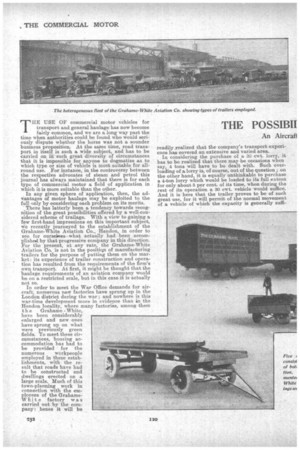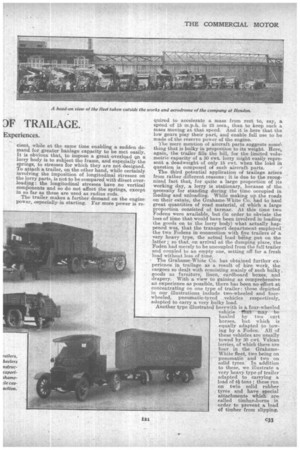THE POSSIBII DF TRAILAGE.
Page 10

Page 11

If you've noticed an error in this article please click here to report it so we can fix it.
An Aircraft
Experiences.
THE USE OF commercial motor vehicles for transport and general haulage has now become fairly common, and we are a long way past the time when authorities could be found who would seriously dispute whether the horse was not a sounder business proposition. At the same time, road transport. in itself is such a wide subject, and has to be carried on in such great diversity of circumstances
i that it s impossible for anyone to dogmatize as to which type or size of vehicle is most suitable for allround use. For instance, in the controversy between the respective advocates of steam and petrol this journal has always maintained that there is for each type of commercial motor a field of application in which it is more suitable than the other.
In any given sphere of application, then, the advantages of motor haulage may be exploited to the full only by considering each problem on its merits. ' There has latterly been a tendency towards recognition of the great possibilities offered by a well-considered scheme of trailage. With a view to gaining a few first-hand impressions on this important subject, we recently journeyed to the establishment of the Grahame-White Aviation Co., Hendon, in order to see for ourselvea what actually had been accomplished by that progressive company in this direction. For the present, at any rate, the Grahame-White Aviation Co. is not in the positien of manufacturing trailers for the purpose of putting them on the market: its experience of trailer construction and operation has resulted from the requirements of the firm's own transport. At first, it might be thought that the haulage requirements of an aviation company would be on a restricted scale, but in this case it is actually not so.
In order to meet the War Office demands for aircraft; numerous new factories have sprung up in the London district during the war ; and nowhere is this war-time development more in evidence than in the Hendon locality, where many factories, among them t h e Grahame White, have been considerably enlarged and new ones have sprung up on what were previously green fields. To meet these circumstances, housing accommodation has had to be provided for the numerous workpeople employed in these establishments, with the result that roads have had to be constructed and dwellings erected on a large scale. Much of this town-planning work in connection with the employees of the GrahameWhi te factory was carried out by the company: _hence it will be
readily realized that the company's transport experience has covered an extensive and varied area.
In considering the purchase of a 30 cwt. lorry, it has to be realized that there may be occasions when say, 4 tons will have to be dealt with. Such overloading of a lorry is, of course, out of the question ; on the other hand, it is equally unthinkable to purchase a 4-ton lorry which would be loaded to its full extent for only about 5 per cent, of its time, when during the rest of its operation a 30 cwt. vehicle would suffice. And it is here that the trailer proves to be of such great use, for it will permit of the normal movement of a vehicle of which the capacity is generally suffi cient, while at the same time enabling a sudden demand for greater haulage capacity to be met easily. It is obvious that, to impose a great overload en a lorry body is to subject the frame, and especially the springs, to stresses for which they are not designed. To attach a. trailer, on the other hand, while certainly. involving the imposition of longitudinal stresses on the lorry parts, is not to be compared with direct overloading: the longitudinal stresses have no vertioal components and so do not affect the springs, except in so far as these are used as radius rods.
The trailer makes a further demand on the engine power, especiallyin starting. Fax more power is re
quired to accelerate a mass from rest to, say, a. speed of 15 m.p.h. in 25 secs., than to keep such a mass moving at that speed. And it is here that the low gears play their part, and enable full use to be made of the reserve power of the engine. The mere mention of aircraft parts suggests some% thing that is bulky in proportion to its weight. Here, again, the trailer fills the bill, for the limited volumetric capacity of a 30 cwt. lorry might easily represent a deadweight of only 15 cwt. when the lo-ad in question is composed of such aircraft parts.
The third potential application of traalage arises from rather different reasons : it is due to the recognized fact that, for quite a large proportion of its working day, a lorry is stationary, because of the necessity for standing during the time occupied in roading and unloading. While making up the roads on their estate,. the Graharne-White Co. had to haul great quantities of road material, of which a large proportion consisted of tarmac. At this time two Fodens were available, but (in order to obviate the loss of time that would have been involved in loading the goods on to the lorry body) what actually happened was, that the transport department employed ' the two Fodens in connection with five trailers of a very heavy type, the actual load being put on the latter ; so that, on arrival at the dumping place, the Foden bad merely to be uncoupled from the full trailer and coupled to an empty one, setting off for a fresh load without loss of time.
• The Grahame-White Co. has obtained further experience in trailage as a result of hire work, the cargoes so dealt with consisting mainly of such bulky_ goods as furniture., linen, cardboard boxes, and drapery. With a view to gaining as comprehensive an experience as possible, there has been no effort at concentrating on one type of trailer: those depicted. in our illustrations include two-wheeled and fourwheeled, pneurnatie-tyred vehicles respectively, adapted to carry a. very bulky load. Another type illustrated herewith is a four-wheeled vehicle tintt. may be hauled by two cart horses, but which is equally adapted to towing by a Foden. All of these vehicles are usually towed by 30 cwt. Vulcan lorries, of which there are four in the Grahame. White fleet, two being on pneumatic and two on solid tyres. In addition to these, we illustrate a very heavy type of trailer adapted to carrying a load of 41 tons ; these run on twin solid rubber tyres and have special attachments which are called timber.horns in order to prevent a. load of timber from slipping.






















